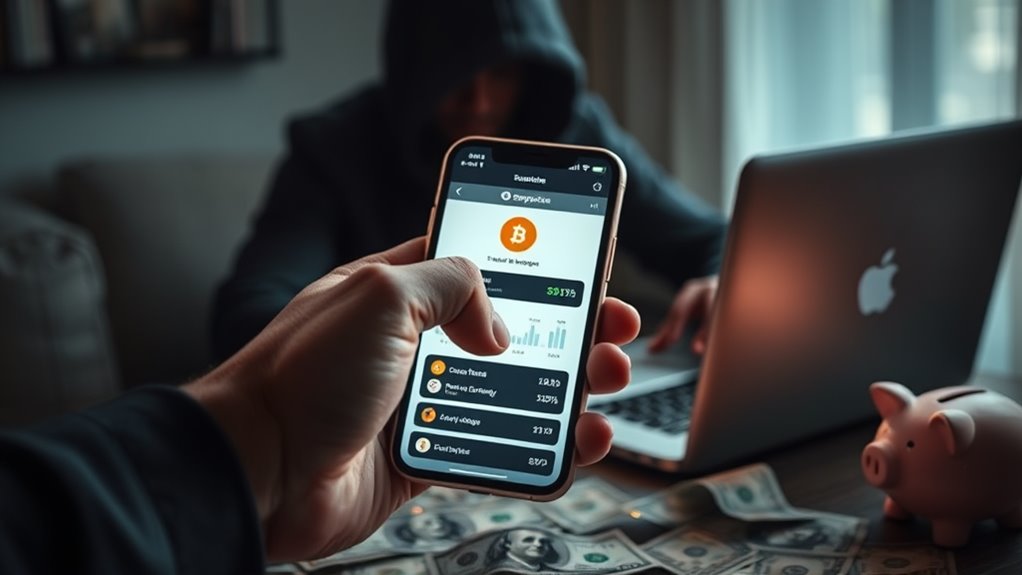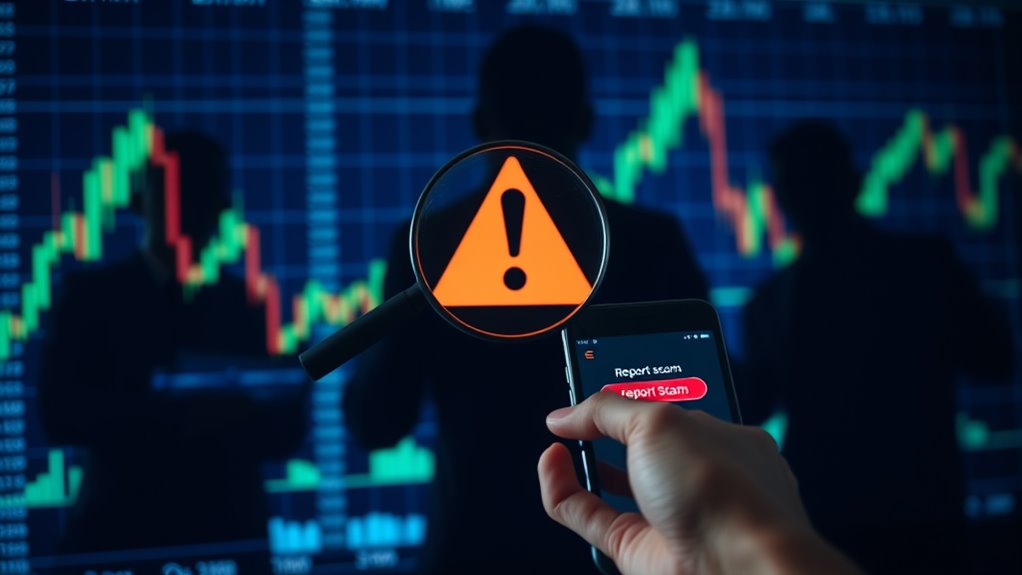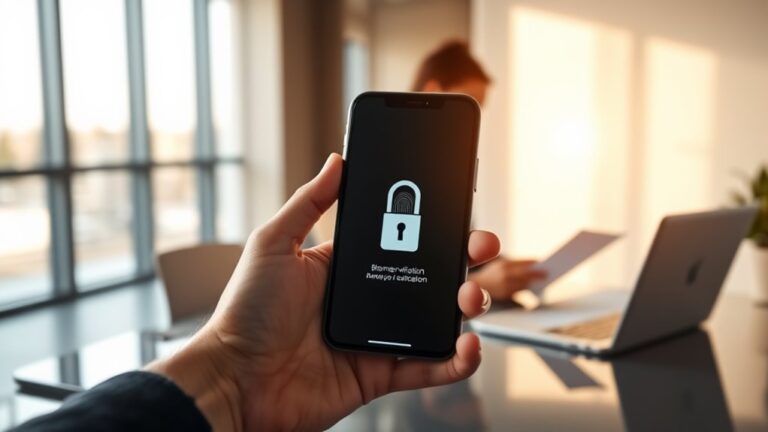
Crypto Exchange Scams: How to Spot and Avoid Them
Cryptocurrency exchange scams extracted nearly $9.9 billion in 2024, with annual growth of 24% since 2020. Common schemes include Ponzi schemes, fake exchanges, rug pulls, and phishing campaigns. Warning signs involve unrealistic returns, withdrawal difficulties, limited transparency, and high-pressure tactics. Investors should implement multi-factor authentication, conduct thorough research, verify regulatory compliance, and check community feedback. Cold storage solutions and regular security audits further protect assets. The following sections offer extensive protection strategies against these evolving threats.
Key Takeaways
- Verify an exchange’s regulatory compliance and security features like cold storage before depositing funds.
- Be wary of platforms promising guaranteed high returns, which often signal Ponzi schemes.
- Implement multi-factor authentication and strong passwords to protect your cryptocurrency accounts.
- Research thoroughly by checking community forums, review sites, and the exchange’s leadership transparency.
- Test withdrawals with small amounts first and avoid platforms requesting additional payments to access your funds.
The Rise of Cryptocurrency Exchange Scams

As digital currencies have gained mainstream popularity, cryptocurrency exchange scams have emerged as a significant threat in the financial landscape. In 2024 alone, these scams received at least $9.9 billion, with an average annual growth rate of 24% since 2020.
Cryptocurrency scams now account for nearly half of all financial fraud losses in America, despite representing only 10% of financial transactions. The increasing sophistication of these operations includes professional infrastructure like Huione Guarantee, which supports complex scam networks.
Crypto scams dominate financial fraud landscape while innovating with sophisticated support networks like Huione Guarantee.
Scammers increasingly employ advanced technologies, including AI and deepfakes, to create convincing fake investment opportunities.
They particularly target vulnerable populations such as elderly individuals, who lost significant amounts through crypto ATM scams in 2023. Implementing multi-factor authentication is crucial for users to enhance their security and reduce the risk of falling victim to these scams.
Common Types of Crypto Exchange Fraud Schemes

Cryptocurrency exchange scams come in several deceptive forms, with Ponzi schemes attracting investors through promises of impossible returns while using new investments to pay earlier participants.
Fake exchanges employ sophisticated website cloning techniques to create legitimate-looking platforms that ultimately steal deposited funds.
Rug pull strategies involve developers abandoning a cryptocurrency project after raising substantial investment, deliberately crashing the token value and leaving investors with worthless assets.
Ponzi Scheme Mechanics
While legitimate cryptocurrency exchanges facilitate genuine trading, Ponzi schemes in the crypto world operate on a fundamentally deceptive principle. These fraudulent systems disguise themselves as investment opportunities, using funds from new investors to pay returns to earlier participants rather than generating actual profits from legitimate business activities.
| Characteristic | Warning Sign | Example |
|---|---|---|
| Return Promises | Unrealistically high gains with minimal risk | “Guaranteed 10% weekly returns” |
| Structure | Multi-level referral systems | Heavy rewards for bringing in new investors |
| Transparency | Limited financial information | Vague explanations about trading strategies |
| Technology Use | Blockchain exploitation | Smart contracts that restrict withdrawals |
Investors should remain vigilant for these red flags, especially when platforms emphasize recruitment over actual trading activities. The most successful schemes often leverage cryptocurrency’s technical complexity to create an illusion of legitimacy while operating outside regulatory oversight. Additionally, understanding the risks associated with hacks is crucial for identifying potential fraud in the ever-evolving crypto landscape.
Fake Exchange Tactics
Numerous fake cryptocurrency exchanges employ sophisticated deception strategies to separate investors from their digital assets.
These platforms often utilize domain name spoofing, creating websites that closely resemble legitimate exchanges but contain subtle differences in URLs. Their operational tactics include:
- Creating overwhelming promises of unrealistic returns to attract vulnerable investors
- Implementing limited withdrawal capabilities that allow only small amounts before completely blocking access
- Employing fake customer support representatives who mislead victims into paying additional “processing fees”
- Integrating romance scams to build trust before directing victims to fraudulent platforms
- Using impersonation techniques with similar logos, interfaces, and branding of established exchanges
These tactics are particularly effective because they exploit both technical vulnerabilities and human psychology, making even experienced investors susceptible to well-crafted scams that appear legitimate at first glance. Additionally, utilizing strong passwords with two-factor authentication can help protect against unauthorized access to your accounts and reduce the risk of falling victim to these scams.
Rug Pull Strategies
Among the most devastating forms of cryptocurrency fraud, rug pulls represent a sophisticated strategy where developers abandon a project after collecting substantial investments, leaving investors with worthless tokens. These deceptive schemes often begin with excessive marketing and unrealistic promises of returns.
| Type of Rug Pull | Key Characteristics |
|---|---|
| Liquidity Pulls | Sudden draining of funds from token pools |
| Fake Projects | Seemingly legitimate ventures that vanish after funding |
| Pump and Dump | Artificial price inflation followed by developer sell-off |
| Team Exit | Complete disappearance of development team |
To avoid falling victim, investors should thoroughly research project teams, verify security audits, and engage with established communities. Transparency is vital—be wary of anonymous teams and projects lacking technical documentation. Statistics show rug pulls accounted for 37% of cryptocurrency scam revenues in 2021, totaling $2.8 billion in losses. Furthermore, as the crypto market evolves, new regulations are being implemented to help protect investors from such fraudulent activities.
Red Flags That Signal a Potential Scam

Identifying crypto exchange scams requires vigilance and awareness of common warning signs. Potential investors should scrutinize platforms carefully before committing funds, as scammers employ sophisticated tactics to appear legitimate.
Key red flags include:
- Promises of guaranteed or risk-free returns with unusually high profit potential
- Difficulty withdrawing funds or requests for additional payments to access your money
- Lack of transparency about company leadership, physical address, or regulatory compliance
- Exclusive acceptance of cryptocurrency payments with no alternative transaction methods
- High-pressure sales tactics urging immediate investment decisions
These warning signs often appear together, creating a pattern of deception.
Legitimate exchanges maintain transparency about their operations, provide clear withdrawal processes, and never guarantee specific investment returns. Additionally, a secure exchange should incorporate security features that protect users from potential threats.
When encountering multiple red flags, investors should exercise extreme caution and conduct additional research.
How Scammers Target Crypto Exchange Users

Scammers employ an increasingly sophisticated arsenal of techniques to target unsuspecting cryptocurrency exchange users, exploiting both technological vulnerabilities and human psychology. They utilize phishing campaigns, fake platforms, and credential harvesting to deceive users into revealing sensitive information or transferring funds to fraudulent accounts.
| Tactic | Method | Impact |
|---|---|---|
| Phishing | Spoofed emails mimicking exchanges | Stolen login credentials |
| Social Engineering | Creating false urgency | Hasty, poor decisions |
| Fake Platforms | Cloned exchange websites | Direct theft of deposits |
| Credential Harvesting | Fake recovery pages | Compromised wallets |
| Business Email Compromise | Impersonating trusted entities | Misdirected transfers |
These attacks often exploit users with limited cryptocurrency literacy, employing misspelled domains and emotional manipulation to bypass security awareness. As techniques evolve, continuous vigilance remains essential for users to protect their digital assets. Additionally, using secure wallets can significantly enhance the safety of your investments.
Essential Security Measures for Crypto Investors

Implementing multi-factor authentication adds an essential security layer that can prevent unauthorized access even if passwords are compromised.
Cold storage solutions, which keep crypto assets offline, considerably reduce the risk of theft through online attacks and should form the backbone of any investor’s security strategy.
Regular security audits of exchange platforms and personal wallets help identify vulnerabilities before they can be exploited, allowing investors to stay one step ahead of potential threats. Additionally, utilizing a user-friendly interface can help investors navigate security settings more effectively and enhance their overall safety.
Multi-Factor Authentication Implementation
Securing your cryptocurrency investments begins with establishing robust multi-factor authentication (MFA) protocols on all exchange accounts. This essential security measure requires multiple forms of verification, greatly reducing the risk of unauthorized access even if your password is compromised.
To implement MFA effectively:
- Enable MFA through your exchange account settings
- Download a reputable authenticator app like Google Authenticator
- Link the app to your account by scanning the provided QR code
- Set up backup recovery options in case your device is lost
- Regularly update your MFA settings and authentication applications
MFA combines something you know (password), something you possess (mobile device), and sometimes something inherent (biometrics). Additionally, incorporating KYC regulations can enhance security by verifying user identities and assessing risks, further protecting your investments.
While SMS-based verification offers some protection, authenticator apps and hardware security tokens provide superior security against modern crypto exchange scams.
Cold Storage Benefits
Cold storage represents the gold standard in cryptocurrency security practices, moving beyond online authentication methods to fundamentally different protection architecture.
By keeping private keys completely offline, cold storage solutions like hardware wallets and metal plates dramatically reduce exposure to online threats including hacking, phishing, and exchange breaches.
For investors holding assets long-term, cold storage provides vital protection by ensuring complete control over private keys without reliance on third-party platforms.
Hardware wallets from trusted brands like Ledger and Trezor offer robust security features while maintaining user-friendly interfaces.
Additionally, businesses benefit through risk mitigation, compliance with regulatory standards, and increased investor confidence.
Best practices include regular firmware updates, physical safeguarding, and maintaining multiple secure backups of recovery seeds—creating an extensive security strategy that balances protection with accessibility when needed.
Regular Security Audits
Regular security audits serve as the backbone of cryptocurrency protection strategies, providing investors with systematic defenses against evolving threats. These evaluations identify vulnerabilities before malicious actors can exploit them, ultimately preventing financial losses and maintaining regulatory compliance.
Investors should prioritize exchanges that demonstrate commitment to security through:
- Transparent audit schedules with publicly available results
- Engagement of specialized blockchain security firms for technical reviews
- Implementation of thorough testing methodologies including penetration tests
- Clear documentation of remediation steps following audit findings
- Continuous monitoring systems between formal audit periods
The audit process typically follows a structured approach of preparation, execution, reporting, and follow-up implementation. Additionally, exchanges that utilize decentralized exchanges can offer enhanced security features, further reducing risks associated with centralized platforms.
Due Diligence Before Using an Exchange Platform

Why should investors thoroughly research a cryptocurrency exchange before entrusting it with their assets? Proper due diligence helps users identify legitimate exchanges and avoid potential scams that could result in financial loss.
Investors should verify regulatory compliance, particularly KYC/AML procedures, and understand the exchange’s legal jurisdiction.
Examining security measures, such as two-factor authentication and cold storage solutions, is essential. Users should assess the platform’s financial stability through transparent reporting and investor backgrounds.
Operational aspects like extensive user screening and sanctions compliance indicate a trustworthy exchange.
Additionally, checking for smart contract audits, insurance against losses, and clear dispute resolution processes provides further protection.
Online reviews and ratings offer valuable insights into the exchange’s reputation and reliability. Moreover, selecting exchanges like Coinbase for beginners can enhance the likelihood of a secure trading experience.
Steps to Take If You’ve Been Scammed

Despite careful research and prevention efforts, cryptocurrency scams can still impact even vigilant investors. When victimized, taking immediate action is essential for potential recovery and prevention of further losses.
- Document all details of the scam, including transaction information, communications, and wallet addresses involved.
- Report the incident to local law enforcement, national fraud agencies, and the cryptocurrency exchange where the scam occurred.
- Secure your accounts by changing passwords, enabling two-factor authentication, and moving remaining funds to a secure wallet.
- Consider consulting with reputable cryptocurrency recovery professionals who have verifiable credentials and transparent processes.
- Prevent future incidents by staying informed through trusted news sources and online communities focused on cryptocurrency security.
Recovery from cryptocurrency scams requires prompt action and thorough documentation while maintaining vigilance against secondary scams targeting victims.
Regulatory Developments in Crypto Exchange Protection

The landscape of cryptocurrency regulation has dramatically evolved in recent years, reflecting both the industry’s maturation and increased concerns about investor protection. Recent SEC initiatives include rescinding SAB 121 and launching a dedicated Crypto Task Force aimed at developing extensive guidelines that balance innovation with investor safety.
| Regulatory Development | Impact on Investor Protection |
|---|---|
| SEC Crypto Task Force | Developing clear frameworks for asset management |
| SAB 121 Rescission | Integrating crypto assets into financial services |
| International Cooperation | Preventing regulatory arbitrage across borders |
| New Accounting Guidelines | Standardizing practices for crypto assets |
These changes signal a shift from primarily enforcement-based approaches toward establishing clearer operational standards. By addressing regulatory gaps exploited by scammers and creating consistent frameworks, authorities aim to reduce vulnerabilities while supporting legitimate market growth.
Community Resources for Verifying Exchange Legitimacy

While regulatory efforts establish formal protections, cryptocurrency users must also leverage community-based resources to verify exchange legitimacy before entrusting their assets.
Online forums like Reddit and Bitcointalk, along with review platforms such as TrustPilot, provide valuable insights from experienced users who share both positive experiences and concerning issues.
- Examine social media engagement patterns, looking for meaningful interactions beyond promotional content
- Verify official documentation including white papers, roadmaps, and transparent team information
- Check security protocols such as two-factor authentication, cold storage, and insurance policies
- Review domain registration history and website professionalism as indicators of legitimacy
- Assess industry partnerships and community feedback across multiple platforms to establish credibility
These community-vetted resources help users develop a thorough understanding of an exchange’s reputation before making financial commitments.
Frequently Asked Questions
Are Crypto Losses From Scams Tax-Deductible?
Currently, crypto losses from scams are generally not tax-deductible in the US under the Tax Cuts and Jobs Act of 2017, as theft is not considered a disposal of a capital asset for tax purposes.
How Quickly Can Funds Be Recovered After a Scam?
Recovery time after a scam varies considerably. Factors include speed of reporting, type of cryptocurrency, and jurisdictional issues. Immediate action offers better chances, but the process may take months or even years to resolve.
Do Hardware Wallets Completely Eliminate the Risk of Scams?
Like a castle with impenetrable walls yet vulnerable gates, hardware wallets greatly reduce but don’t eliminate scam risks. They protect against online threats but users remain susceptible to phishing, compromised devices, and human error.
Can VPNS Protect Against Crypto Exchange Hacks?
VPNs can enhance security by encrypting traffic and masking IP addresses, but they cannot protect against all exchange hacks. They are useful tools within a broader security strategy, not complete solutions alone.
Are Insured Exchanges Safer Than Non-Insured Ones?
Like umbrellas in a downpour, insured exchanges offer greater protection than non-insured ones. They typically implement stronger security measures and provide recourse for lost funds, markedly reducing overall risk for cryptocurrency investors.
Conclusion
Cryptocurrency exchange scams can devastate investors with losses that could fund small nations. By recognizing warning signs, conducting thorough research, and implementing robust security practices, users can markedly reduce their vulnerability. As regulations evolve and community vigilance increases, the crypto landscape becomes safer—but ultimate responsibility rests with individual investors. Stay informed, remain skeptical, and prioritize security to navigate the complex world of cryptocurrency exchanges successfully.












